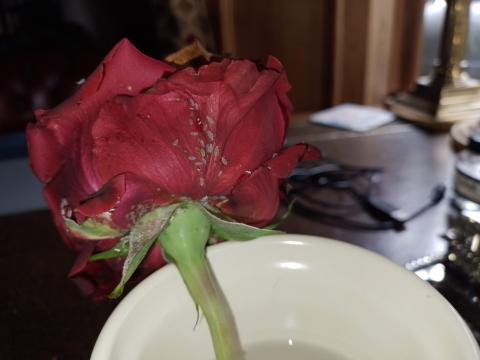Aphididae

I cut a rose and placed it in a small vase so I might better enjoy it as I worked at my desk. Within a few days, it was crawling with aphids. They were technically feeding off a corpse, but it made little difference to them. Eventually, the petals would have fallen and these pests would have dropped off and crawled about my desk in search of pastures new.
Annoyingly, I have been struggling to be rid of another type of aphid which has been feeding off houseplants in a different room. They were blown in, presumably, when the doors or window were left ajar; six months later and I am still spraying soapy water and daily inspecting leaves to squash them.
While away in London and Northumberland this spring, I returned to find my climbing rose crawling with these tiny green monsters. One week’s respite in dispatching them resulted in entire colonies covering leaves, buds and stems. So how do they do it?
-They are viviparous, which means they lay eggs in the autumn and winter, but they give birth to live young during the spring and summer, which means they can more quickly grow and spread. It is possible that these young, called nymphs, are born already pregnant.
-They employ asexual reproduction called parthenogenesis. Courtesy of virgin births, they can just reproduce without troubling themselves to look for a suitable partner.
-When sap from a plant is so depleted that it can no longer support the aphid colony, they can grow wings and fly to a new host and begin afresh. If sap is plentiful, they do not bother with wings and make do with walking.
-They are avid reproducers. None of them put their careers before families; S.A. Marshall in Insects: Their Natural History and Diversity estimates that under perfect conditions and without predation, a single aphid could produce 600 billion more in just a single season! Although this is wonderful news for ladybirds, it is a poor tiding for gardeners, farmers and humble growers of potted plants.
As I write this, my skin it itching as I imagine the pesky blighters walking up and down my arms and legs. If you want a picture of sin, go and observe greenfly or blackfly on roses, petunias, sweet peas or sycamores. Like aphids, sin spreads quickly and thoroughly, and must be regularly and consistently checked. It weakens and depletes its host, even though it is skilled at hiding and blending in. As I squash the fat little insects which slowly destroy my plants, so I must put to death the misdeeds of the body, living anew for Christ, and not the flesh with all its decay and weakness.
And those who are Christ’s have crucified the flesh with its passions and desires. Galatians 5:24, NKJV
- Log in to post comments


 Sunday Worship 10.45am & 6.00pm
Sunday Worship 10.45am & 6.00pm